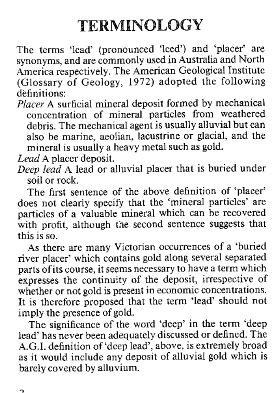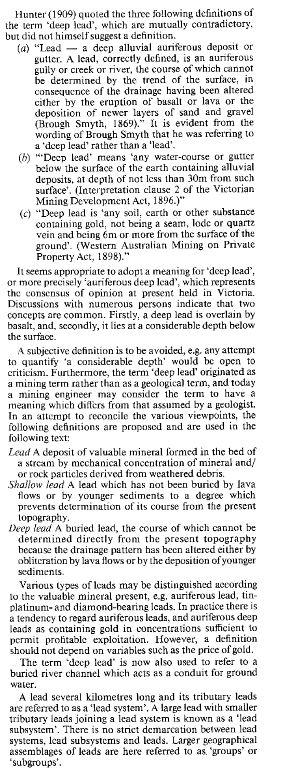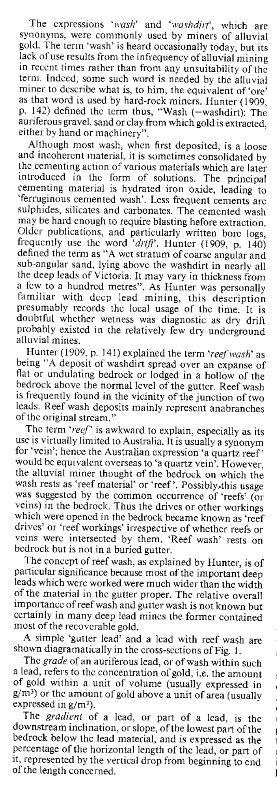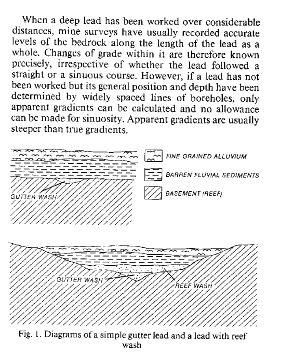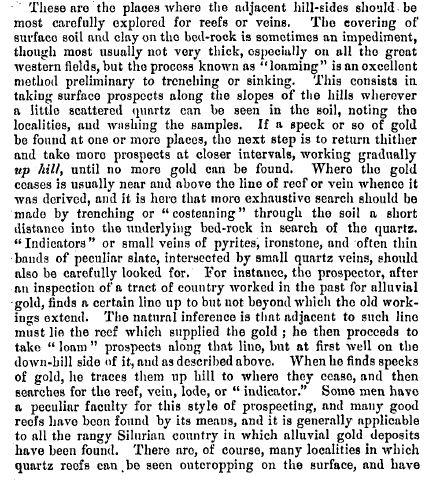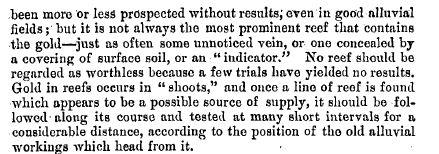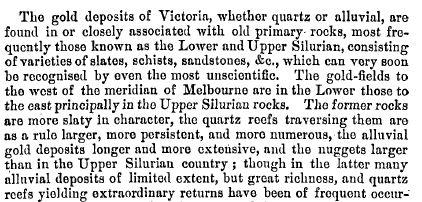US article - not too bad.
Finding gold nuggets with a metal detector may seem simple enough, but it can in fact be one of the most challenging types of metal detecting there is. It certainly seems simple enough; you swing your detector until the coil is over a gold nugget, the detector sounds off, and you dig it up. In reality, while it can be very productive, using a metal detector for gold prospecting can also be extremely frustrating, so lets discuss a few of the challenges that you are likely to face when you start looking for gold with a metal detector, and a few tips that will help you get started on the right track.
The first thing worth emphasizing is to use a metal detector that is specifically designed for finding gold. Just about all metal detectors can detect gold, and manufacturers will often claim that their detectors are good at finding gold, but the truth is only a select group is specifically designed for nugget shooting. The average detector that might do just fine locating coins in a park will probably have fits if you take it out to the gold fields. Areas that produce gold nuggets often have a unique set of challenges associated with them, so lets discuss each of them in detail.
One of the biggest problems with most gold bearing areas is the highly mineralized ground that is associated with it. Most ground contains varying amounts of iron, and gold is usually found in areas that have extremely high amounts of it. This causes that vast majority of metal detectors to struggle, as they will sound off constantly because they are sensing the minerals in the ground. The other pest that you will find in many areas is hot rocks, which are rocks that contain a high amount of mineralization that will make your detector sound off as well. A detector with ground balancing is absolutely essential, but still many detectors will have trouble with this, and it can be just about impossible to cancel out the chatter produced by the mineralized ground to be able to distinguish the difference between it and a gold nugget.
Another problem that is common in many gold areas is high amounts of iron trash. The miners in the early days didnt think much about leaving behind junk. Often they were camped right on their claims, leaving behind old cans, boot tacks, nails, bullets, shovels, snuff cans, and just about anything else you can imagine. High amounts of trash can sometimes be overwhelming, even to an experienced detectorist, but it is something that has to be dealt with if you want to be a good nugget shooter.
Another thing that makes metal detecting for gold nuggets a real challenge is that the vast majority of them are very small. While we would all love to dig up those nice softball sized nuggets that we dream about, the reality is that most of the nuggets that are found with a metal detector are pretty small. We are talking little flakes that might be smaller than a grain of rice. So in order to successfully find gold nuggets on a regular basis we need a detector that is sensitive enough to find the small nuggets, while at the same time be able to handle highly mineralized ground and also distinguish the difference between ferrous trash and a gold nugget.
So now that we have outlined the biggest challenges that we will have to deal with when looking for nuggets, let talk specifically about which detectors are best at dealing with these challenges. I will go ahead and outline some specific brands and models that have good reputations as gold getters, but everyone has their own opinions about what is best. Do your research, weigh the options, and figure out which is best for your needs.
Without getting too deep into specifics, understand that there are basically two types of technology used in metal detectors today; Very Low Frequency (VLF) and Pulse Induction (PI). VLF metal detectors are an older technology, but are used in the majority of the detectors on the market today. They are best at locating small nuggets at fairly shallow depths. PI metal detectors are a newer technology and were specifically designed to detect larger nuggets at deeper depths. While they excel at searching deeper into the soil, they will miss small nuggets that a VLF will find. They are also much more expensive.
In no particular order, some of the most popular VLF metal detectors are the Fisher Gold Bug 2 and Gold Bug Pro, Tesoro Lobo SuperTraq, Garrett AT Gold, Minelab Eureka Gold, and Whites GMT. All of these detectors are well respected for their ability to find small nuggets, as well as discriminate trash and mineralization.
Minelab is by far the winner when it comes to PI metal detectors right now. They basically been the only show in town when it comes to high quality PI detectors, and they are by far the favorite of many serious nugget shooters. The older models include the SD2100, SD 2200 and GP3000, up to the most recent models which include the GPX 4500 and GPX 5000. The Whites TDI is another newer PI detector, but currently it doesnt have near the following that the Minelabs have.
Okay, so now that we have learned about good quality gold detectors and some of the obstacles that we will have to deal with, it is time to actually go out and find some gold nuggets!
The very first thing you should do when you get a new metal detector is read the owners manual. After you have read it, start at the beginning and read it again. The key to successfully finding gold with a metal detector is to understanding your machine, so take the time to really learn it; how it works, the different adjustments, how to ground balance it, etc. One thing all successful nugget shooters have in common is an intimate knowledge and understanding of their machine.
If there is one secret to finding gold, this is it; search where gold has been found before. In the case of metal detecting for gold, you need to search where nuggets have been found in the past. Some areas have produced plenty of gold, but not in sizes large enough to be found with a metal detector. Many of the gold bearing states in the eastern US would be a good example of this. Some areas have produced gold, but only dust and small flakes. If you want to find gold with a metal detector, you need to seek out areas that have a history of producing nuggets.
Dont just metal detect randomly. A common mistake is to assume that just because gold was found in a general area, that you can go anywhere in that area, turn on your metal detector and start digging up nuggets. Find the exact areas that the old timers worked. Look for old placer tailing piles, places where miners hand stacked rocks along a creek. Find those prospects in the side of the hill where someone did some digging. Look for large areas dug up with bucket line dredges or big hydraulic pits. If you are in an arid region, look for drywasher piles left behind by the old timers. Anything that shows sign that gold has been found in the area before is a good indication that it can be found today. The early prospectors were great at finding gold, but they didnt have metal detectors, so you have the chance of finding gold that they missed.
Once you have found a good looking area, its time to start metal detecting. The first thing you need to do is ground balance your metal detector to the mineralization in the soil. Since you read your owners manual you already know how to do this (you did read it, right?) If you really have found a good location that was worked by the early day gold prospectors, there is a good chance that right away youre going to get a strong signal from your detector, and you will dig a rusty nail. Youll move forward a few feet and get another hit, and you will dig up another rusty nail. You will go another few feet and dig up ten more nails, an old beer can, four little unidentified bits of iron, and a piece of bird shot. You have learned about the scourge of the modern day prospector trash.
This is where learning the language of your metal detector will really pay off. The fact is that even guys that are really good at finding gold nuggets with a metal detector still dig a lot of trash. It is just a part of the sport, and it is something that you just have to deal with to some extent. However, learning your machine will really help cut down on the amount of digging you have to do. Quality discrimination should be able to separate out much of the nonferrous targets that you go over with your detector, either by producing a different tone than gold makes, or by blanking them out completely. Each metal detector handles it differently, so learning your machine and how different types of trash sound compared to gold are extremely important if you want to be successful.
Its always a good idea to bring a test nugget out into the field with you. Take a small nugget and glue it to a poker chip or guitar pick, something that is not made of metal and large enough that you wont lose it. This will help you tune your ear to the sound of gold and what you should be listening for.
Another bit of encouragement... if you are digging small pieces of lead, you are on the right track. It is almost impossible to distinguish the difference between lead and gold. While this can definitely be frustrating if you get into an area that has bullets and bird shot everywhere, you should also think of it as a good thing. If you are able to detect a small piece of bird shot, you will be able to find a small piece of gold. Often it just takes time, and maybe hundreds of pieces of trash before you are lucky enough to find that first piece of gold, but if you are persistent you will be rewarded.
Metal detecting for gold nuggets is probably the toughest type of metal detecting, certainly much different than digging up coins at the park. Nuggets are generally small, the ground is highly mineralized, and often there is metal rubbish scattered everywhere. Still, when you find that first gold nugget there is a good chance that you will be hooked for life. Good Luck!





